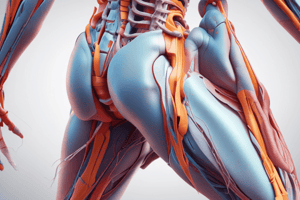Podcast
Questions and Answers
Which of the following best defines kinesiology?
Which of the following best defines kinesiology?
- The study of human movement or motion (correct)
- The study of the nervous system
- The study of bones and joints
- The study of the cardiovascular system
Anatomic kinesiology focuses solely on the skeletal system.
Anatomic kinesiology focuses solely on the skeletal system.
False (B)
What is structural kinesiology concerned with in relation to muscles?
What is structural kinesiology concerned with in relation to muscles?
Structural kinesiology is concerned with the involvement of muscles in the science of movement.
More than ______ muscles are found in the average human body.
More than ______ muscles are found in the average human body.
Match the following terms related to biomechanics with their correct definition:
Match the following terms related to biomechanics with their correct definition:
Which of the following professionals might benefit from a strong understanding of kinesiology?
Which of the following professionals might benefit from a strong understanding of kinesiology?
Understanding kinesiology is only valuable for treating injuries and has no impact on improving physical conditioning.
Understanding kinesiology is only valuable for treating injuries and has no impact on improving physical conditioning.
Why is understanding kinesiology important for coaches and trainers?
Why is understanding kinesiology important for coaches and trainers?
Which of the following is NOT a type of arthrokinematic motion?
Which of the following is NOT a type of arthrokinematic motion?
The fundamental position is identical to the anatomical position.
The fundamental position is identical to the anatomical position.
What is the directional term that refers to being 'above in relation to another structure'?
What is the directional term that refers to being 'above in relation to another structure'?
The term _______ refers to the back or posterior part.
The term _______ refers to the back or posterior part.
Match the following directional terms with their definitions:
Match the following directional terms with their definitions:
What is the anatomical term for lying face downward?
What is the anatomical term for lying face downward?
The term 'cephalic' refers to the neck region.
The term 'cephalic' refers to the neck region.
What is the term for the front part of the body?
What is the term for the front part of the body?
The term relating to the palm of the hand is called ________.
The term relating to the palm of the hand is called ________.
Which of the following is part of the axial region of the body?
Which of the following is part of the axial region of the body?
The ankle is proximal to the knee.
The ankle is proximal to the knee.
What is the definition of 'superficial' in anatomical terms?
What is the definition of 'superficial' in anatomical terms?
The sternum is located on the _________ side of the body.
The sternum is located on the _________ side of the body.
Which term describes something above & toward midline?
Which term describes something above & toward midline?
Match the following body regions with theirs parts
Match the following body regions with theirs parts
Flashcards
Kinesiology
Kinesiology
The study of motion or human movement.
Anatomic Kinesiology
Anatomic Kinesiology
Study of the human musculoskeletal & musculotendinous systems.
Structural Kinesiology
Structural Kinesiology
Study of muscles involved in the science of movement.
Muscle Variation
Muscle Variation
Signup and view all the flashcards
Biomechanics
Biomechanics
Signup and view all the flashcards
Kinematics
Kinematics
Signup and view all the flashcards
Kinetics
Kinetics
Signup and view all the flashcards
Relevance of Kinesiology
Relevance of Kinesiology
Signup and view all the flashcards
Osteokinematics
Osteokinematics
Signup and view all the flashcards
Arthrokinematics
Arthrokinematics
Signup and view all the flashcards
Anatomical Position
Anatomical Position
Signup and view all the flashcards
Fundamental Position
Fundamental Position
Signup and view all the flashcards
Anterior
Anterior
Signup and view all the flashcards
Posterior
Posterior
Signup and view all the flashcards
Superior
Superior
Signup and view all the flashcards
Inferior
Inferior
Signup and view all the flashcards
Proximal
Proximal
Signup and view all the flashcards
Distal
Distal
Signup and view all the flashcards
Ipsilateral
Ipsilateral
Signup and view all the flashcards
Contralateral
Contralateral
Signup and view all the flashcards
Deep
Deep
Signup and view all the flashcards
Superficial
Superficial
Signup and view all the flashcards
Prone Position
Prone Position
Signup and view all the flashcards
Study Notes
Introduction to Kinesiology
- Kinesiology is the science of human movement
- It applies evidence-based research to improve human function, health, and wellness
- This research is used in all settings and populations
Kinesiology & Body Mechanics
- Kinesiology is the study of motion or human movement
- Anatomical kinesiology studies the musculoskeletal and musculotendinous systems
- Structural kinesiology studies how muscles function in movement
- Skeletal and muscular structures are involved in movement
- Bones have various sizes and shapes, affecting joint movement
Types of Muscle
- More than 600 muscles are found in the human body
- Muscles vary in size, shape, and structure throughout the body
- There are three types of muscle: cardiac, skeletal, and smooth
Who Needs Kinesiology?
- Anatomists, coaches, strength and conditioning specialists, personal trainers, nurses, physical educators, physical therapists, physicians, athletic trainers, massage therapists, and others in health-related fields need kinesiology
Why Kinesiology?
- Kinesiology requires a thorough understanding of large muscle groups to help others improve their strength and maintain body function
- Professionals should understand the "why" behind exercises, not just how to perform them, particularly in athletic conditioning and training
- Kinesiology allows physical educators to understand and improve physical conditioning through skill analysis
Biomechanics
- Mechanics is the branch of physics that analyzes how forces affect particles and mechanical systems
- Biomechanics is a specialization of mechanics used with living organisms (specifically humans)
Subdivisions of Biomechanics
- Statics - study of bodies at rest
- Dynamics - study of bodies in motion
- Kinematics - study of the description of motion, including space and time factors
- Osteokinematics - the gross movement of bones at joints (e.g., flexion/extension, abduction/adduction, internal/external rotation)
- Kinetics - study of the action of forces
- Arthrokinematics - the small-scale movements at joint surfaces (e.g., roll, glide/slide, spin)
Reference Positions
- Anatomical position is a common, accurate reference point for describing joint movements
- A person is standing upright, with feet parallel and close together, and facing forward, with palms forward
- Fundamental position is similar to anatomical position, except the arms are at the side, and palms face the body.
Basic Terminologies
- Anterior - front
- Posterior - back
- Medial - middle
- Lateral - side
- Superior/Cephalad - above
- Inferior/Caudal - below
- Proximal - closer to the trunk/origin
- Distal - farther from the trunk/origin
Anatomical Directional Terminology
- Anterolateral, Posteromedial, Anteromedial, Posterosuperior, Anteroposterior are various combinations of other terminology
Anatomical directional terminology (other terms)
- Contralateral - opposite side
- Ipsilateral - same side
- Bilateral - both sides
- Inferior/Infra - below
- Superior/supra - above
- Deep - beneath the surface
- Superficial - near the surface
Anatomical directional terminology (additional terms)
- Caudal - below
- Cephalic - above
- Prone - face downwards
- Supine - face upwards
- Dorsal - back side of the body
- Ventral - front side of the body
- Palmar - relating to palm of the hand or sole of the foot
- Plantar - relating to sole or undersurface of the foot
Body Surface
- Various anatomical parts and regions in the body and their positions
Body Regions
- Axial - Cephalic (Head), Cranium & Face, Cervical (Neck), Thoracic (Thorax), Dorsal (Back), Abdominal (Abdomen), & Pelvic (Pelvis)
- Appendicular - Upper Limbs, Shoulder , arm, forearm, & manual, Lower Limbs, thigh, leg, & pedal
Skeletal System
- The adult skeleton has 206 bones, and 80 bones are part of the axial skeleton, while 126 bones belong to the appendicular skeleton
- Skeletal functions include protection, support, movement, mineral storage, and blood cell formation.
Types of Bones
- Long bones (e.g., humerus, femur, fibula)
- Short bones (e.g., carpals, tarsals)
- Flat bones (e.g., skull, sternum, scapulae)
- Irregular bones (e.g., vertebrae, pelvis, ethmoid, ear ossicles)
- Sesamoid bones (e.g., patella, pisiform)
Studying That Suits You
Use AI to generate personalized quizzes and flashcards to suit your learning preferences.




